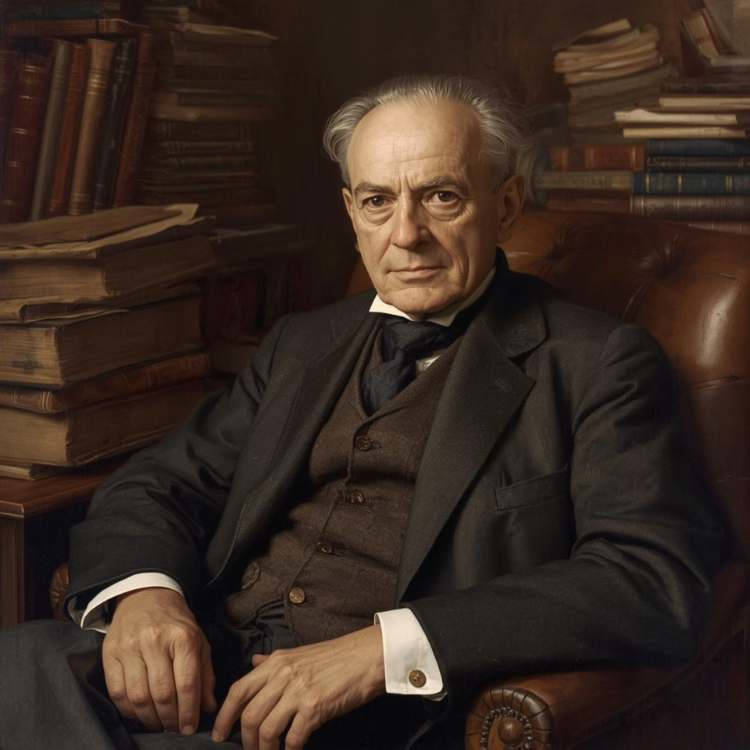
Few poets have reshaped the literary world as profoundly as T.S. Eliot. A man of extraordinary intellect, Eliot bridged the chaos of the modern world with a new poetic vision that was both intellectually demanding and emotionally raw. His masterpiece, The Waste Land (1922), became the defining poem of the 20th century—an exploration of spiritual desolation, cultural decay, and the search for renewal in an age of fragmentation.
In this article, we’ll explore Eliot’s life, influences, key works, and lasting impact on literature and modern thought. 🌍
🧠 Early Life and Education: The Making of a Modern Mind
Thomas Stearns Eliot was born on September 26, 1888, in St. Louis, Missouri, into a well-to-do and intellectually inclined family. His father, Henry Ware Eliot, was a successful businessman, while his mother, Charlotte Stearns Eliot, was a poet and social reformer.
From an early age, young Eliot displayed a keen intellect and a reflective nature. However, as a child, he suffered from health issues, which led him to spend much time indoors, reading voraciously. This early immersion in literature—from Shakespeare and Dante to the metaphysical poets like John Donne—laid the foundation for his future style: intellectually rigorous, allusive, and deeply philosophical.
Eliot attended Harvard University, where he studied philosophy and literature, graduating in 1909. He later spent a year in Paris, studying at the Sorbonne, absorbing French Symbolist poetry (especially that of Baudelaire and Laforgue), which profoundly influenced his poetic voice. He eventually returned to Harvard for graduate studies in philosophy but soon left for Oxford University, where he would settle permanently in England—the land that would become his home and the setting for his literary career.
🇬🇧 A Transatlantic Transformation: From America to England
When Eliot arrived in England in 1914, World War I had just begun. Though initially planning to return to the United States, he soon decided to stay. He found the intellectual vibrancy of London irresistible and quickly became part of a circle of influential modernist writers and artists, including Ezra Pound, who became his mentor and literary champion.
It was Pound who recognized Eliot’s genius early on, calling him “the only one among us capable of producing a masterpiece.” Under Pound’s encouragement, Eliot refined his early work and published Prufrock and Other Observations (1917), a collection that heralded a new era of poetry.
🕰️ “The Love Song of J. Alfred Prufrock” – A Modern Voice Emerges
Published in 1915, The Love Song of J. Alfred Prufrock was unlike anything readers had seen before. Its opening lines immediately broke from poetic convention:
“Let us go then, you and I,
When the evening is spread out against the sky
Like a patient etherized upon a table…”
Instead of romantic imagery, Eliot gave readers a jarring, clinical image, setting the tone for the psychological fragmentation that defines modernist poetry. The poem portrays Prufrock, an insecure and introspective man, paralyzed by indecision and alienation—a reflection of modern humanity’s spiritual crisis.
Eliot’s use of free verse, shifting perspectives, and fragmented imagery mirrored the disordered consciousness of modern life. The poem’s brilliance lay not only in its form but in its emotional honesty. Through Prufrock, Eliot captured the voice of a generation lost amid the noise of urban modernity.
⚡ The Waste Land (1922) – The Poem That Changed Everything
If Prufrock announced Eliot as a major poet, The Waste Land cemented his place as a literary revolutionary. Published in 1922—the same year as Joyce’s Ulysses—this complex, multi-layered poem became a symbol of the post–World War I world.
Structured as a collage of voices, myths, and literary allusions, The Waste Land depicts a civilization in ruins, where faith, meaning, and connection have crumbled. Its famous opening lines are unforgettable:
“April is the cruellest month, breeding
Lilacs out of the dead land…”
Eliot juxtaposed ancient myth with modern despair, moving seamlessly from references to the Holy Grail legend to scenes of urban desolation. The poem’s fragmented structure mirrored the shattered psyche of the modern world, while its spiritual undercurrent hinted at the possibility of redemption.
Interestingly, The Waste Land was heavily edited by Ezra Pound, whose cuts helped shape its final form. Eliot later described Pound as “il miglior fabbro”—“the better craftsman”—a tribute included in the poem’s dedication.
✍️ Eliot the Critic: Redefining Literary Tradition
Beyond his poetry, T.S. Eliot was a brilliant literary critic whose essays transformed how literature was read and taught. In his famous essay Tradition and the Individual Talent (1919), Eliot argued that great poets must understand and engage with the literary tradition that precedes them. He saw literature as a living continuum where innovation must coexist with an awareness of the past.
He also introduced the concept of the “objective correlative”—the idea that emotion in art should be expressed through a concrete set of objects, situations, or events rather than direct expression. This became a guiding principle for many modernist writers and remains a cornerstone of literary criticism today.
⛪ Spiritual Crisis and Renewal: Eliot’s Religious Turn
By the late 1920s, Eliot’s personal life was marked by emotional turmoil and dissatisfaction. His first marriage, to Vivienne Haigh-Wood, was deeply troubled, and his growing disillusionment with modernity led him to seek meaning in religion.
In 1927, Eliot converted to Anglicanism and became a British citizen. This spiritual rebirth profoundly influenced his later poetry, which began to reflect themes of faith, redemption, and moral responsibility.
His works from this period, including Ash Wednesday (1930) and Four Quartets (1943), reveal a poet striving for spiritual unity in a fragmented world. Four Quartets, in particular, is widely regarded as his greatest philosophical and spiritual achievement, exploring time, memory, and divine order through lyrical and meditative language.
“We shall not cease from exploration,
And the end of all our exploring
Will be to arrive where we started
And know the place for the first time.”
These lines capture Eliot’s lifelong journey toward meaning and transcendence—a journey both deeply personal and universally human.
🎭 The Dramatist: From Verse to Stage
Eliot was not only a poet but also a playwright. In the 1930s and 1940s, he sought to revive verse drama for modern audiences. His plays, such as Murder in the Cathedral (1935) and The Cocktail Party (1949), blend philosophical reflection with compelling human drama.
Murder in the Cathedral, which dramatizes the martyrdom of Thomas Becket, explores the conflict between spiritual conviction and worldly power. It was both a critical and popular success, cementing Eliot’s reputation as a writer of immense versatility. His later plays continued to explore moral and existential themes, often with a subtle humor and social insight.
🏆 Recognition and Legacy
In 1948, Eliot received the Nobel Prize in Literature “for his outstanding, pioneer contribution to present-day poetry.” By then, his influence was global. Poets, scholars, and readers alike looked to Eliot as the voice who had articulated the anxieties and hopes of the modern age.
His work inspired generations of poets, from W.H. Auden and Seamus Heaney to Sylvia Plath and Ted Hughes. Even today, echoes of Eliot’s style and themes resonate in literature, music, and popular culture.
🕊️ Eliot’s Enduring Influence on Modern Thought
T.S. Eliot’s work continues to challenge and inspire because it confronts the deepest questions of human existence: How do we find meaning in a world that seems meaningless? How do we reconcile intellect and emotion, faith and doubt?
Eliot’s genius lay in his ability to capture the modern condition—its alienation, confusion, and yearning for order—without offering easy answers. His poetry invites readers into a dialogue with the past, urging them to seek truth amid the noise of modern life.
Even a century later, The Waste Land and Four Quartets remain among the most studied and quoted works in English literature. Eliot’s words remind us that out of chaos can come clarity, and out of despair, the possibility of renewal. 🌱
💬 Famous Quotes by T.S. Eliot
✨ “Only those who will risk going too far can possibly find out how far one can go.”
✨ “Genuine poetry can communicate before it is understood.”
✨ “This is the way the world ends / Not with a bang but a whimper.”
These lines capture the depth and ambiguity that define Eliot’s poetic vision—a balance between intellect and emotion, modernity and tradition, despair and hope.
📚 Conclusion: The Poet of Modern Humanity
T.S. Eliot was not just a poet of his time—he was a poet for all times. His work continues to resonate because it reflects the eternal struggle to find meaning, faith, and coherence in an uncertain world.
From Prufrock’s hesitant steps through the city’s fog to The Waste Land’s desolate landscape and Four Quartets’ spiritual transcendence, Eliot’s journey mirrors our own search for understanding. His poetry invites us to look beyond the surface of life and discover the deeper rhythms that connect us all.
Through his modernist innovation, spiritual insight, and intellectual brilliance, Eliot forever changed the course of literature. And as readers, we continue to walk with him through the wasteland—seeking, questioning, and, ultimately, discovering. 🌍✨
Sources:
- The T.S. Eliot Society Archives
- The Nobel Prize Official Website
- “The Letters of T.S. Eliot” (Faber & Faber, 2011–2022)
- The Cambridge Companion to T.S. Eliot (Cambridge University Press, 2015)
- British Library: “T.S. Eliot and Modernism”

